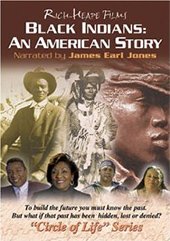
Videos
Black Indian An American Story
"Black Indians: An American Story" (as seen on ABC) brings to light a hidden heritage of America's past ‐ the cultural and racial fusion of Native and African Americans. Narrated by James Earl Jones, “Black Indians: An American Story” explores what brought the Native and Black Native Americans together, what drove them apart and the challenges they face in the 21st century.
Distinguished Awards:
- Award of Distinction, Indian Summer Festival 2005
- Cine Golden Eagle 2002
- Crystal Award of Excellence, Communicator Awards 2002
- Best Documentary, Native American Music Awards 2002
- Aurora Gold Award 2001
A society that wants to build the future must know its origin, its real Native American heritage, as it was.” But what if Native American oral histories had been lost, forgotten, hidden, or denied?
“Black Indians: An American Story,” explores the issue of racial identity among Native and African Americans. This in-depth documentary examines the native ancestry and the coalescence of these Indian tribes in American history. Discounted, and often ignored by mainstream America, these minority peoples have often shared a common native history. However, with their heritage ignored and their contributions denied they are all but invisible at the dawn of the new millennium.
The stories of the Native Americans and African-Americans are actually parallel tracks of tragedy. Indeed, from the colonial era through the 19th century, the intermingling of these peoples combined two diverse worlds into a new mixed race of people who have courageously withstood attempts erase their unique twin cultural heritage despite the efforts of both black and Indian movements as well as the dominant white society.
It was a black and white world in the early days of the Republic and little or no thought was given to people of a mixed race color line, especially if they looked "black.” “We were told ‘if you could pass for white, that's who you'd be; if not, it was usually better to be identified as black than Indian,’" recalls Executive Producer Steven Heape. Yet as a minority of two minorities, black Indians - sometimes called the "ultimate survivors" and once referred to as mulattos or people of color - often feel ostracized for being neither Indian nor black enough. "It was this kind of 20th century thinking that later led to ‘pencil genocide’--changing one’s race on a birth certificate to fit the skin color of the child.”
Those interviewed in the film talk of the "erasing of ancestors" that took place when the government singularly designated grandparents or parents as black, Indian, or white
"It's very much a matter of belonging," says Mr. Richie, who directed the film that was more than two years in the making. "If they grow up in a black neighborhood, they likely adapt to a black culture. Likewise, if they grow up on a reservation, they adapt to a Native American culture. But even within these confines, they feel disclaimed and discriminated against."
Since 1998, Rich-Heape Films has produced a series of videos dealing with genealogy, civilized tribes, history of black natives, health issues, and traditional Indian storytelling. Black Indians is the latest in this Circle of Life collection.�
"This film affirms to African Americans that it's OK to come to the surface and say, 'Yes, I'm part Indian. "They're not giving up their blackness; they're just recognizing their Indian heritage." "Just as the Jewish holocaust victims don't want their story forgotten, neither do the Black Indians," adds Mr. Heape. "As sad as that story is, it's part of our heritage and history."
James Earl Jones agreed to narrate the film and the Neville Brothers provided music because they felt the neglected story needed telling.
Mr. Jones did the narration for the film giving the project instant credibility. Why? Turns out, it's a matter of roots.
"My answer is very simple: I'm part Cherokee through my grandmother," Mr. Jones says. "That is why I was particularly interested in the project."
The Neville Brothers have been told all their lives that they have American Indian heritage. So Cyril Neville and his brothers, whose music is an amalgamation of jazz, R&B, and reggae, provided the music.
"The Great Spirit who moves through all things meant for the Neville Brothers to do this," says the percussionist from his home in New Orleans. "It was a blessing to be involved because it helped answer questions I've been wondering about all my life."
The film is healing, Mr. Neville says, and helps people like him understand their sometimes confused backgrounds. "When you know the truth, it sets you free. As another citizen of the First Nation said, 'The truth may sleep, but it never dies. "
"Black Indians: An American Story" is a distinguished documentary which presents the rarely-told story of the racial fusion of Native and African-Americans. It is a story which literally begins with the birth of America, in the presence of the mixed-race Boston Massacre martyr Crispus Attucks, and which follows the deadlier aspects of the 19th century through the Seminole War (where runaway slaves joined Seminole warriors in Florida in armed conflict against the invading U.S. Army) and the expulsion of the Cherokee nation on the infamous Trail of Tears (where black Indians within the Cherokee orbit faced the no-win choice of either leaving with their brethren into forced exile or staying behind to live in slavery).
While Native Americans did not carry the racial hang-ups of white society's former slave trade and did not see mixed-raced Indians as being second-class, white society and 19th century government bureaucrats had no concept of multiculturalism and demanded that everyone be pigeonholed into one racial group, with any questions of identity decided by appearance. Thus, it was not uncommon for black Indian families to find themselves separated by government classifications into completely different racial groups based solely on their color and appearance. This practice was also helpful in erasing official traces of Native American Nations in the late 19th century--mixed race Indians were not considered pure native blood by the Bureau of Indian Affairs and several tribes were declared extinct even though they still lived in the persons of black Indians whose native heritage was not recognized by the government. By the 1960's, the civil rights movement and Native rights movement roared into the national forefront. Telling people the story of the black Indians was virtually forgotten except as family histories by those who shared the blended racial heritages. Even today, black Indians meet incredulous skeptics who refuse to acknowledge their ancestral worth.
"Black Indians: An American Story" is rich with interviews with people of mixed Native and African-American heritage, and the true surprise here is actually the level of prejudice which these individuals experienced from the African-American community. While it would come as no surprise that black skinned African American men and women have been (and continue to be) treated in a humiliating manner by a predominantly white society, it comes as a sting to learn that African-American society also heaps excesses of ridicule on black Indians based on the hue of their skin and the blithe dismissal of their multicultural Native American background with the misplaced notion that black people can only possess an Afrocentric heritage. It comes as little comfort to learn that racism is not a one-way street originating in white neighborhoods, and it is to director Chip Richie's credit that the film addresses this shameful situation.
"Black Indians: An American Story" offers an engrossing history lesson which celebrates a forgotten piece of the American mosaic. This documentary teaches an invaluable lesson in the value of ethnic pride and it pays beautiful tribute to brave Americans who kept alive their heritage in the face of unparalleled circumstances. This film should be required viewing for people of all races, ethnicity and mind frames
Steven R. Heape - Executive Producer/Producer
Chip Richie - Director/Producer
James Earl Jones - Narrator
Neville Brothers - Soundtrack
Daniel Blake Smith - Screenwriter
Howard Tyler - Editor
Running Time 60 Minutes. Rated for all ages.
Close Captioned. NTSC All Regions.


